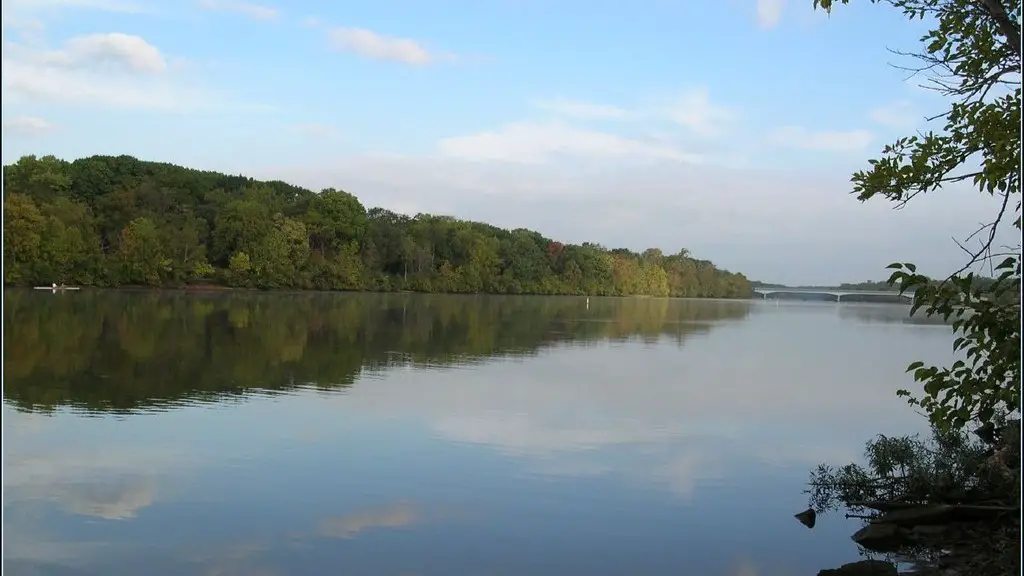The mighty Mississippi River, one of the most iconic landmarks in North America, is facing an ongoing severe crisis of diminishing water flow. According to the US Geological Survey, over the last 100 years, water levels throughout the 2,340-mile long river have declined sharply due to changes in land use, over-pumping of groundwater and the need for more water in cities and towns. This has caused a reduction in the flow of the Mississippi River and raised concerns over its water quality, flow levels and its future sustainability.
The root cause of the declining flow of the Mississippi River can be mainly attributed to human activities such as over-pumping of groundwater for drinking water, agricultural production and industrial processes. Additionally, changes in land use, such as deforestation and urban expansion, have also exascerbated the issue by increasing the amount of runoff and sediment entering the river. This in turn has lead to a decrease in the amount of available surface water, making it difficult for the river to sustain its normal low and high flow levels.
The impact of this declining water flow is being felt across the US Midwest, where agricultural, industrial and recreational activities rely on the Mississippi River. As the river struggles to sustain adequate flow levels, it has become increasingly difficult and costly for farmers, engineers and water resource managers to meet their water needs. This has caused a number of agricultural, industrial and recreational activities to be significantly impacted.
The US Army Corps of Engineers are actively monitoring the situation and have put in place a number of measures to help alleviate the impact of the declining water flow, such as conservation measures and improved regulation of water use. They also have been working with other government agencies, as well as private stakeholders, to help develop strategies for sustaining water levels in the Mississippi River.
However, despite these efforts, there is still a long way to go in protecting and restoring the flow levels in the Mississippi River. The issue of water scarcity and the need to manage it more sustainably is a global problem, and the solutions must come from a collective effort in order to have any real impact. It is therefore important for governments and private stakeholders to take more proactive steps in developing policies and practices that can help protect and conserve the river’s flow levels, while also allowing for the demands of population growth in the US Midwest.
Economic Impact
The economic impact of the declining flow of the Mississippi River has been significant. The river serves as a vital waterway for transportation and commerce in the US Midwest, and substantial amounts of goods, ranging from agricultural products to manufactured goods, are transported through the river on a daily basis. As the flow of the river has been reduced, it has become more difficult and costly for businesses to transport goods due to higher portage costs and longer travel times. This has in turn caused some businesses to be forced out of the market, leading to an increased unemployment rate in certain areas and decreased economic output for the region.
Additionally, the reduced water flow in the Mississippi River has caused a decrease in the amount of water available for recreational activities, such as boating, fishing, swimming and camping. This in turn has lead to decreased numbers of visitors to areas near the river, which has had a direct impact on businesses such as restaurants, hotels and souvenir shops that rely on tourism for their economic sustainability.
Environmental Impact
The declining water flow in the Mississippi River has also had a negative impact on the river’s health. As the river’s flow has decreased, it has become more susceptible to pollution, as pollutants and excess sediment can accumulate in the stagnant water causing an increase in the river’s nutrient levels. This in turn leads to increased algal growth and an increase in the amount of oxygen-depleting substances, resulting in the death of fish and other aquatic life. This can cause major disruptions to the river’s fragile ecosystem, as well as disrupting the livelihood of those who rely on the river for sustenance. Additionally, lower levels of water in the river can also lead to water shortages in areas near the Mississippi River, which can increase the risk of waterborne-diseases and have a major impact on public health.
Solutions
In order to reduce the impact of the declining water flow in the Mississippi River, it is essential that governments and private stakeholders work together to create policy and practice that can help protect and conserve the river’s flow levels. This could include improving existing water conservation measures, encouraging the adoption of renewable energy sources and using water more efficiently in industrial processes. Additionally, it would also be important to improve land use and reduce the rate of deforestation and urban sprawl, as this can contribute significantly to the reduction of runoff and sediment entering the river.
It is also important for people to become more aware of water conservation and to understand the importance of conserving the river’s flow. This can be achieved by encouraging the public to adopt sustainable water-use practices, as well as developing campaigns to educate people about the need to protect and preserve the Mississippi River.
Legal Challenges
The declining water flow in the Mississippi River has also led to a number of legal challenges. This is due to the need to protect the river’s flow under both US federal law and the laws of the US states, as well as the need to balance this with the rights of private stakeholders in terms of their water rights. These legal challenges are complex and require a delicate balance between the need to protect the river’s flow and the rights of businesses and individuals. It is therefore essential that governments and private stakeholders work together to develop effective and sustainable policies that will protect and conserve the Mississippi River.
Economic Benefits
Despite the challenges posed by the declining Flow of the Mississippi River, there are also some economic benefits that can be achieved from protecting and conserving the river’s flow. For example, by investing in improved water-use efficiency, improving water conservation measures and promoting the adoption of renewable energy sources, businesses and individuals can reduce their water use and help to reduce the environmental impact of the river. Additionally, by conserving the river’s flow, businesses and individuals can also benefit from increased access to water for recreational activities, as well as increased employment opportunities, increased tourism and increased economic output throughout the US Midwest.
Conclusion
The declining flow of the Mississippi River has been a major concern for many years, and it is essential that governments and private stakeholders take more proactive steps to protect and conserve the river’s flow. This can be achieved through improved water-use efficiency, improved water conservation measures and the adoption of renewable energy sources. By doing this, people can help to protect the river and ensure its sustainability for future generations.



